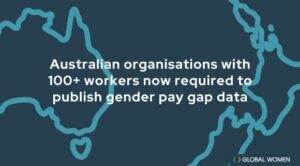
Australia has officially passed a bill through parliament that will help ensure the reporting of pay gaps.
All organisations with 100 or more staff will, as of early 2024, need to publish the gender pay gaps in their midst thanks to the passing of the Workplace Gender Equality Amendment (Closing the Gender Pay Gap) Bill 2023.
The pay gap data will be publicly published on the Workplace Gender Equality Agency (WGEA) website, alongside guides and resources to help employers take action.
Four and a half million Australian employees will now get greater clarity on their employers’ pay gaps.
Four and a half million Australian employees will now get greater clarity on their employers’ pay gaps, considering this measure covers around 40% of the nation’s workforce.
Considering the current Australian pay gap sits at around 22.8%,* women on average earn $26,596 less than men a year, only 22.3% of Australia’s CEOs are women and 1 in four organisations have a gender-balanced leadership team, this is a welcome step in levelling out the figures.
…Over half of Australian employers carried out a gender pay gap analysis this year. However, of those, 40% took no action as a result.
Like many pay gap reforms and bills around the world, the goal was to not only reform but also spark action through transparency. “That is why an essential part of the legislative reforms is to give employers the option to provide a statement that gives context to their gender pay gap results and outlines their plans for action,” shares Workplace Gender Equality Agency (WGEA) CEO, Mary Wooldridge, on the matter.
Locally, we’ve seen efforts to encourage voluntary pay gap reporting, as well as encouraging similar legislative commitments to Australia’s passed bill — top of mind being MindTheGap NZ and their Public Pay Gap Registry, created by many Global Women Members.
Closer to Global Women, the Champions for Change, a local collective 80 leading CEOs and Chairs of New Zealand organisations, are reporting their own organisational pay gaps—among myriad other data—in their efforts to accelerate inclusive and diverse leadership in our workplaces.
A touch over half of Australian employers carried out a gender pay gap analysis this year. However, of those, 40% took no action as a result.
It’s clear much of the responsibility rests in the hands of employers to do the internal dot-connecting, matched with strong equity-focused structures to reap the benefits that this bill intended.
[Increasing] the number of women in leadership was the most common goal. Less popular among employers, were setting targets to increase the number of men taking parental leave or to increase the number of men in female dominated roles.
Internal strategies are a must, by this bill, for some organisations: employers with 500 or more staff will need a policy or roadmap for each of the six Gender Equality Indicators.
Some businesses— precisely 53%—of those filing reports in 2022 have set targets on their own. WGEA reports that increasing the number of women in leadership was the most common goal. Less popular among employers, however, were setting targets to increase the number of men taking parental leave or to increase the number of men in female dominated roles.
Interestingly, orbital bills in Australian politics suggest that the increase of paid parental changes and access to cheaper childcare are on the legislative horizon.
It’s clear that a collective effort is in order to realise the full potential of these strategies—or rather, of women and their remuneration and contributions. One that’s supported by shared responsibility and consistency from all players no matter how big or small, to leave a legacy.
